The Belalp Hexe: A Bewitching Ski Race in Switzerland
In 1983, the Ski Club of Belalp—a tiny village in the southern Swiss Canton of the Valais—founded one of the most bewitching ski competitions in the world: The Belalp Hexe. Or “The Belalp Witch.”
In its first year, the race attracted roughly 300 skiers. However, as I learned through email correspondence with Natascha Abgottspon of Blatten-Belalp Tourismus, that number increased to 986 participants on average, with hundreds of volunteers. The primary race, known as “Hexenabfahrt,” or “Witches’ Descent,” begins in Hohstock, Belalp, and finishes in Blatten, 1322 meters above sea level. According to race organizers, the fastest skiers travel 12 kilometers in 10 minutes.
So, what makes the Belalp Hexe different from other ski races? It’s simple. Organizers split competitors into two: “Racers” and “Witches.” The Witches, many of whom are amateurs, sport pointy hats, capes, face paint, wigs, and sometimes brooms as they descend the mountain. Some never even make it to the finish line. Those who do are assessed by a jury on originality, makeup, entertainment, and skiing performance, as part of a costume competition.
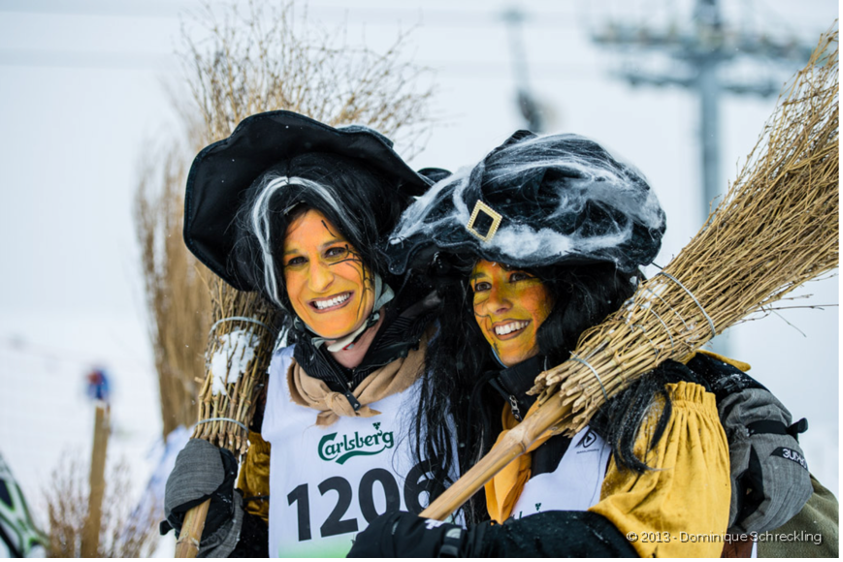
(Photo: Dominique Schreckling, copyright. Used with permission.)
Beyond the Witches’ Descent, the Belalp Hexe comprises several events and celebrations. Without great detail, the website describes the elusive “Witches’ Night” opening ceremony as a “witch dance around the pyre.” In the vibrant Mini-Maxi Race, costumed children and families ski down the mountain.
As the Belalp Hexe’s 42nd Edition approaches, we might ask: Why was the Belalp Hexe founded? What are its origins? How does it exist within a broader history of the Alps?
The Ski Club of Belalp allegedly founded the Belalp Hexe Ski Race to attract tourists during the unpopular weeks after end-of-year holidays. However, whilst that might have been the practical why, the underlying drivers are far more fascinating.
The Legend of the Belalp Hexe
The Swiss are no strangers to Witch legends. In fact, Switzerland had one of the highest incidences of Witch executions between the 14th and 18th centuries. But more on that later! Inspiration behind the Belalp Hexe Ski Race did not stem from overarching folklore— but from a particular tale. Unfortunately, online accounts of the Belalp Hexe, especially in English, are scarce and contradictory. However, I was fortunate to correspond via email with Director Wicca Meier-Spring of the Hexenmuseum Schweiz, or “Witches’ Museum,” of Switzerland. She shared the most comprehensive account of the Belalp Hexe Legend I could find anywhere, yet the origins of which I am uncertain.
As paraphrased and interpreted by me, it goes as follows:
The Belalp Hexe was burned at the stake in Hegdron, at the “Hägsch-Schädji,” or “Witches’ Harm,” based on accusations of murder and “raven flight” many centuries ago.
Before that, she caused profound distress among authorities—including Albrecht Gessler, a Swiss land tax collector, who allegedly referred to her as “that Witch!” Tithe collectors vied for her taxes, as the border between Naters and Rischinen divided her house, causing jurisdictional chaos.
Furthermore, her unhappy marriage to farmer Sepp vom Hegdorn spurred controversy as far as Lüsga, roughly 5.2 kilometers away. Rumors of her mistreatment of him and an affair in Birgisch fueled contempt for her and a belief she possessed supernatural powers. Due to the considerably rugged 3-kilometer distance between Hegdron and Birgisch, many believed she shapeshifted into a raven to see her lover. They claimed to witness them flying together as blackbirds. One man insisted he once observed them turn into humans.
Sepp remained apathetic, focusing on his beloved Valais goats and Kirsch-Schnapps (“Cherry Schnapps”). His pious reputation strengthened local conviction of his immunity to the “Witch’s” antics. Therefore, his sudden death shocked Naters residents! A raven flew over the cherry tree under which Sepp was found at noon—beside him, an empty Kirsch-Schnapps bottle and a ladder.
A farmer, Felix, claimed he had witnessed incriminating activity in the company of Sepp’s wife the day before in Aletschji (where she spent the summer). During his visit, she departed in search of garlic to make soup. At noon, the same time of Sepp’s body’s discovery, Felix heard a raven croaking, and the woman mysteriously reappeared.
The timing and near impossibility of sourcing garlic in Aletschji solidified Felix’s suspicions. He was sure the “Witch” had flown to Naters and back. Somewhere along the way, she must have spotted Sepp picking cherries and, due to their miserable marriage, defecated into his eyes. Therefore, her droppings impaired Sepp’s vision and balance, causing his death from the impact of tumbling down the ladder.
Felix put forth grave accusations, and Hegdorn authorities, searching for motives to accuse the “Witch,” endorsed his account. The woman was captured and confessed to her crimes under brutal torture.
According to Director Meier-Spring and the Blatten-Belalp Tourismus website, the Belalp Hexe Ski Race’s creation was partly to honor Sepp. The Witches’ Descent finish line is allegedly by the tree where Sepp died, and the winner receives a bottle of Kirsch-Schnapps.
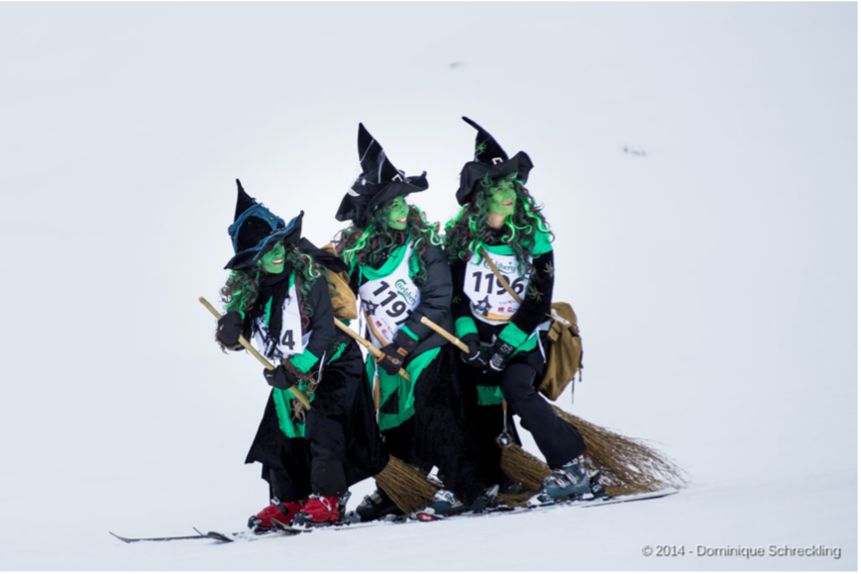
(Photo: Dominique Schreckling, copyright. Used with permission.)
Despite intending to honor the Belalp Hexe’s husband, the Ski Race is arguably—at its best—an inadvertent celebration of her. At its worst, exploitative. Nonetheless, how did local sentiment shift from praising the Belalp Hexe’s execution to celebrating her? Or objectively emulating her? Does the race demonstrate a transformation in discourse about the history of Witch trials in Blatten-Belalp?
These are complex questions—ones to which I do not claim to have answers. Nevertheless, we must return to Witch-hunts in Switzerland to better understand the Belalp Hexe Ski Race’s cultural significance.
Witch-Hunts, Trials, and Persecution in Early Modern Switzerland
In his 2004 book “Witches and Witch-Hunts,” historian Wolfgang Behringer outlines the global history of Witch persecution. He traces the first recorded use of the word “hexerey,” or “witchcraft,” in a Swiss trial to 1400. Therefore, the Belalp Hexe was likely one of the first Witches executed in Switzerland—assuming she was contemporaneous with Albrecht Gessler. Known for his defeat at the hands of Swiss folk hero William Tell circa 1307, Gessler was a legendary Habsburg bailiff. While no historical evidence proves either figure existed, we can still place the Belalp Hexe’s execution in the early 14th century.
The first massive Witch-hunts in Europe happened between 1427-36, soon after the first recorded Witch trial in Switzerland. During that period, the Valais had incredibly high incidences of Witch executions. Behringer estimates 500 victims between 1428-36, with anywhere from 200 to 300 women executed in Upper Valais alone (where Belalp is). Endemic Witch persecutions occurred in Switzerland between 1570-1630, the last 40 years of which constituted the worst Witch-hunts in Europe. For context, Switzerland came second to only Liechtenstein, which executed 10% of its population, in its ratio of Witch-hunting executions to inhabitants. One in every 250 Swiss inhabitants was executed. Or, 4,000 out of 1,000,000.
So, what was different about Swiss lands that led to so many executions? The severity of Witch-hunting in Switzerland and the Valais compared to other Western European regions, as emphasized by Behringer, can be attributed to several factors: socio-environmental crises heightened during the Little Ice Age, destabilized power structures, scapegoating, and a prevailing “Witch-belief.”
Behringer argues that climate deterioration in Swiss Alpine villages was crucial to increased Witch persecution. In 1400, the Valais population’s decision to substitute grain cultivation for cattle farming due to harvest crises coincided with the first recorded mention of “Witchcraft” in a Swiss trial. Villages like Belalp experienced unparalleled ecological catastrophes throughout the 1420s and brutal climate between 1428-29. Surprisingly (or not), those were the years massive Witch-hunts began. Furthermore, the area experienced worsened climatic events during the period known as the Little Ice Age (c. 1303-1850), which intensified in the 1560s. Switzerland’s mountainous topography further added to its vulnerability to decreased temperatures, as difficult transportation and trade escalated the consequences of agricultural failure. In “Belief in Witches and Witch-hunts in the Austrian Alpine Countries,” historian Fritz Byloff indicates that ecologically reliant vine-growing villages, such as those in the Valais, were more affected by Witchcraft accusations and persecutions. Such circumstances allowed scapegoating to gain traction. Witches were blamed for socio-environmental disasters and often accused of what Behringer calls “weather magic.”
Significantly, socio-political crises fanned Witch persecution in Swiss lands. Around 1415, the Valais experienced the “Affair de Rarogne,” a civil war that further destabilized judicial structures. Besides blaming political turbulence, Behringer attributes local despair to especially devastating Black Death plague outbreaks in 1420 and 1428. Swiss clerk Johannes Fründ (c. 1400-68) kept records of the European Witch-hunt starting in Francophone Valais and simultaneously described widespread fertility, agricultural, health, and child mortality concerns.
Moreover, “Witch-belief,” as Behringer calls it, fueled record persecution in modern Switzerland. For example, anthropologist Hans Peter Duerr explores the history of Witches’ flight in the first chapter of his book “Dreamtime.” Duerr describes beliefs that Witches utilized salves (natural ointments) to become birds or anoint brooms and fly away. He argues that although salve explanations in Witch trial records are scarce, judges often assumed the reality of Witches’ flight. Naturally, rumors of flying Witches, like the Belalp Hexe, were more common in areas with disagreeable transportation, such as the Alps.
Lastly, in “Witchcraft, Sorcery, Rumors, and Gossip,” Pamela J. Stewart and Andrew Strathern outline the impact of informal channels of communication in Witch-hunting efforts. Meanwhile, Behringer emphasizes how villages experience heightened social tensions during periods of calamity, as rumors and dissension are often intensified by proximity. Therefore, village structures and gossip exacerbated Witch persecution in the Alps. Purported belief in the Belalp Hexe’s flying abilities, combined with rumors from Felix and unidentified witnesses, led to her ultimate execution.
Did Hegdorn authorities and Valais residents truly believe the Belalp Hexe transformed into a raven and committed mariticide? Was her execution motivated by intensified socio-environmental crises and scapegoating? Was Sepp an alcoholic whose excessive intake of Kirsch-Schnapps resulted in a tragic demise? We will probably never know. We do know, however, that the Belalp Hexe’s execution and that of thousands of others were quite real.
The historical context of Swiss Witch-hunts helps us understand the events within the Belalp Hexe legend. In turn, the legend helps us understand the underlying origins of the Belalp Hexe Ski Race. But how can we bridge the gap between the Belalp Hexe’s execution in the 14th century and the Belalp Hexe Ski Race in 2023?
Changes in Sentiment About Witchcraft in Switzerland and The Belalp Hexe Today
The last legal execution for Witchcraft in Europe was of Anna Göldi in 1782. Given the above, it should not surprise you that it occurred in Glarus, Switzerland.
Since the legal conclusion of Switzerland’s brutal Witch-hunts, national sentiment has undoubtedly changed. The Hexenmuseum Schweiz, founded in 2009, exemplifies such change. Beyond its website and 1200 exhibitions, the Hexenmuseum keeps records of Witch trials in Europe and invites reflection on their historical impact. Arguably, its very existence points to a cultural change in Switzerland, from violently opposing all things “magic” to, at the very least, tolerating education of its history.
In many ways, the Belalp Hexe Ski Race further indicates changes in sentiment within the Valais since the 14th Century. The ski race illustrates a national trend alongside Inferno Mürren and the Allalin Race, as part of the “Super Drei” or “Super Three,” the “most important folk ski races in Switzerland,” according to the Super Drei website. Together, the triad conveys a change in how Witchcraft has become part of what Wolfgang Behringer refers to as a “new event culture” permeated with “Witchcraft tourism”—where legends and folklore are endless, and so are business opportunities.
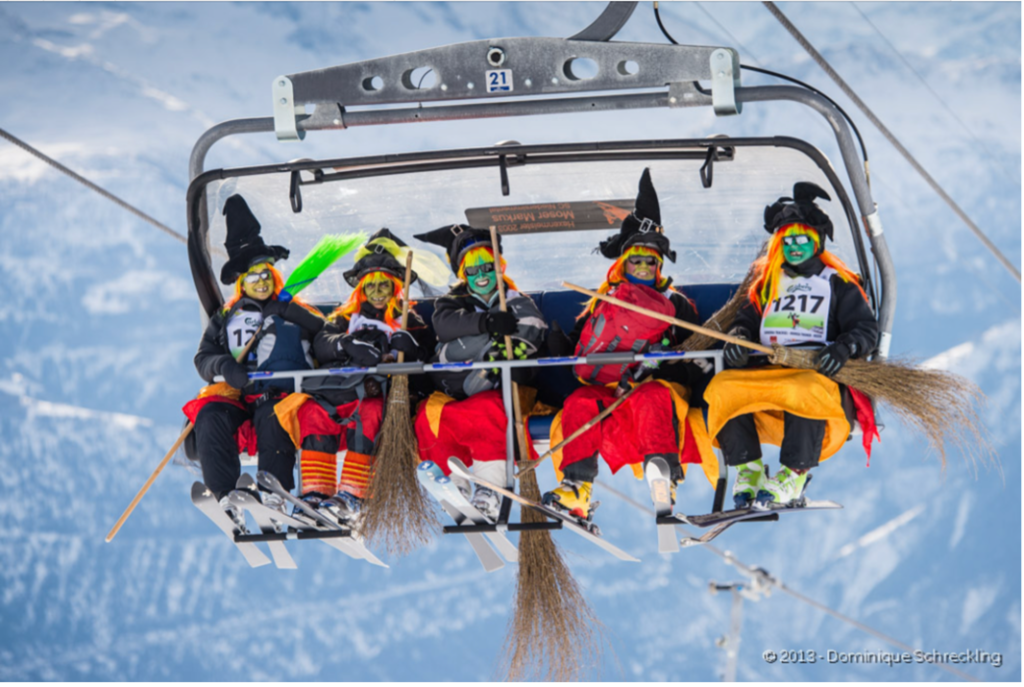
(Photo: Dominique Schreckling, copyright. Used with permission.)
Today, the Belalp Hexe Ski Race adopts several Paganistic, Wiccan rituals beyond the slopes, despite claiming to honor Sepp. Natascha Abgottspon, for example, signed off all her emails to me “with bewitched greetings from Blatten.” Notably, there is a dissonance between originating intent and the behavior of organizers and participants. Yet both connote cultural change.
Between the 14th and 18th centuries, it is improbable that hundreds would gather around a pyre and perform “Witch Dances” or purposefully appear “Witch-like” to race down a mountain in what could be considered “magical” gadgets. Besides fearing execution, possible celebrants knew locals hated Witches.
Yet despite the somewhat exalting tone with which hundreds of racers impersonate the Belalp Hexe, they imitate her for their amusement and ski down the same mountain that she was executed for allegedly flying over. Besides being inextricable from the charges behind the Belalp Hexe’s execution, the Ski Race profits from the exploration (or exploitation) of her.
Interestingly, considerable folklore still surrounds the Belalp Hexe. During the Witches’ Descent, the screeching of ravens and blackbirds circling the sky is rumored to make racers dizzy, and many claim to hear the Belalp Hexe’s resounding laughter.
Conclusion: Everything Has a History, and Nothing Exists in a Vacuum
The Belalp Hexe Ski Race is undoubtedly unique. However, it is part of an overarching historical context too. The Belalp Hexe Ski Race, the 14th-century legend behind it, and changing sentiment toward Witches and Witchcraft in Switzerland are all interconnected.
Beyond interconnectedness, several aspects of this research offer paradoxes: the Belalp Hexe Ski Race’s claims of honoring Sepp versus emulating the Belalp Witch and partaking in Paganistic rituals; the glorification of the executions versus their exploitation for profit (even Witchcraft Tourism); the practicality that drives business versus the occult mysteries of an ancient legend; and finally the severity of Witch trials in Switzerland versus the flexibility of oral history.
Posing numerous contradictions and more questions than answers, I offer the following: Skiing and snow sports provide great means for identifying societal trends, and the Belalp Hexe Ski Race is an especially bewitching example.
Acknowledgments
A very special thank you to Dr. Judith A. Miller for a wonderful class and semester—I would go home every day and talk about History of Skiing & Snow Sports to anyone willing to listen. I would also like to kindly thank Director Wicca Meier-Spring of the Hexenmuseum Schweiz for writing to me with a most detailed and comprehensive account of the Belalp Hexe Legend (after midnight in Switzerland, I must note). Thank you also to Natascha Abgottspon from the Tourismus, Marketing & Verkauf Department of Belalp Bahnen AG & Blatten-Belalp Tourismus AG for answering my questions regarding the Belalp Hexe Ski Race. Lastly, thank you to Dominique Schreckling for giving me permission to utilize the incredible photos of the Belalp Hexe seen above.
Bibliography
Allen, E. John B. The Culture and Sport of Skiing: From Antiquity to World War Ll. Massachusetts: University of Massachusetts Press, 2007.
Bailey, Michael David. “Report on Witchcraft in Valais: Hans Fründ.” Essay. In Origins of the Witches’ Sabbath 3, Vol. 3. Magic in History Sourcebooks. University Park, Pennsylvania: The Pennsylvania State University Press, 2021.
Barry, Jonathan, Marianne Hester, and Gareth Roberts. Witchcraft in Early Modern Europe: Studies in Culture and Belief. Cambridge: Cambridge University Press, 2002.
Behringer, Wolfgang. Witches and Witch-Hunts: A Global History. Cambridge: Polity Press, 2008.
Bellwald, Werner. “Rarogne, Affaire De.” Dictionnaire Historique de la Suisse DHS. Accessed April 30, 2023. https://archive.wikiwix.com/cache/index2.php?url=https%3A%2F%2Fhls-dhs-dss.ch%2Ffr%2Farticles%2F017017%2F#federation=archive.wikiwix.com&tab=url.
Boschung, Dietrich, and Jan Bremmer. The Materiality of Magic. Paderborn: W. Fink, 2015.
Burrow, Sylvia. “Trampled Autonomy: Women, Athleticism, and Health.” International Journal of Feminist Approaches to Bioethics 9, no. 2 (2016): 67–91. https://www.jstor.org/stable/90012239.
Byloff, Fritz. Hexenglaube Und Hexenverfolgung in Den österreichischen Alpenländern. Hamburg: Severus Verlag, 2014.
Cowie, Jonathan. Climate Change: Biological and Human Aspects. Cambridge England: Cambridge University Press, 2007.
Datasport. “Home.” Datasport. Accessed April 18, 2023. https://www.datasport.com/en/#calendar.
“Drei: Die Rennserie.” Super Drei. Accessed April 18, 2023. https://super-drei.ch/die-rennserie.php.
Duerr, Hans Peter, and Hans Peter Duerr. Dreamtime: Concerning the Boundary between Wilderness and Civilization. Oxford: Blackwell, 1991.
Eckert, E.A “Boundary Formation and diffusion of plague : Swiss epidemics from 1562 to 1669.” Annales de démographie historique. (1978). https://doi.org/10.3406/adh.1978.1378.
Hexenmuseum Schweiz Kontakt. Accessed April 27, 2023. https://www.hexenmuseum.ch/kontakt.htm
Kanopiadmin (2004) William Tell, tax rebel: Adam Young, Mises Institute. Accessed April 27, 2023. https://mises.org/library/william-tell-tax-rebel.
Levack, Brian P. The Witch-Hunt in Early Modern Europe. London: Routledge, Taylor & Francis Group, 2016.
Natascha Abgottspon (Tourismus, Marketing & Verkauf Department of Belalp Bahnen AG & Blatten – Belalp Tourismus AG), e-mail correspondence with Luiza Sobreira, April 13, 2023.
Oster, Emily. “Witchcraft, Weather and Economic Growth in Renaissance Europe.” The Journal of Economic Perspectives 18, no. 1 (2004): 215–28. http://www.jstor.org/stable/3216882.
Schreckling, Dominique. “Belalp Hexe, the Craziest Ski Competition in the Alps.” IMPress Magazine. Accessed April 10, 2023. https://ipaimpress.com/belalp-hexe-2013/.
Schreckling, Dominique. “Belalp Hexe 2014, a Most Bewitching Ski Competition.” IMPress Magazine. Accessed April 10, 2023. https://ipaimpress.com/belalp-hexe-2014/.
Stewart, Pamela J., and Andrew J. Strathern. Witchcraft, Sorcery, Rumors, and Gossip. Cambridge: Cambridge University Press, 2007. “Swiss Geoportal.” Schweizerische Eidgenossenschaft. Accessed May 2, 2023. https://map.geo.admin.ch/#.
Wernick, Robert. “In Search of William Tell.” Smithsonian Institution Magazine. Accessed April 29, 2023. https://www.smithsonianmag.com/history/in-search-of-william-tell-2198511/.
Wicca Meier-Spring (Hexenmuseum Schweiz Director), e-mail correspondence with Luiza Sobreira, March 27, 2023.
Winkler, Albert. “The Approach of the Black Death in Switzerland and the Persecution of Jews, 1348–1349.” Faculty Publications, (2007).
https://scholarsarchive.byu.edu/facpub/1813
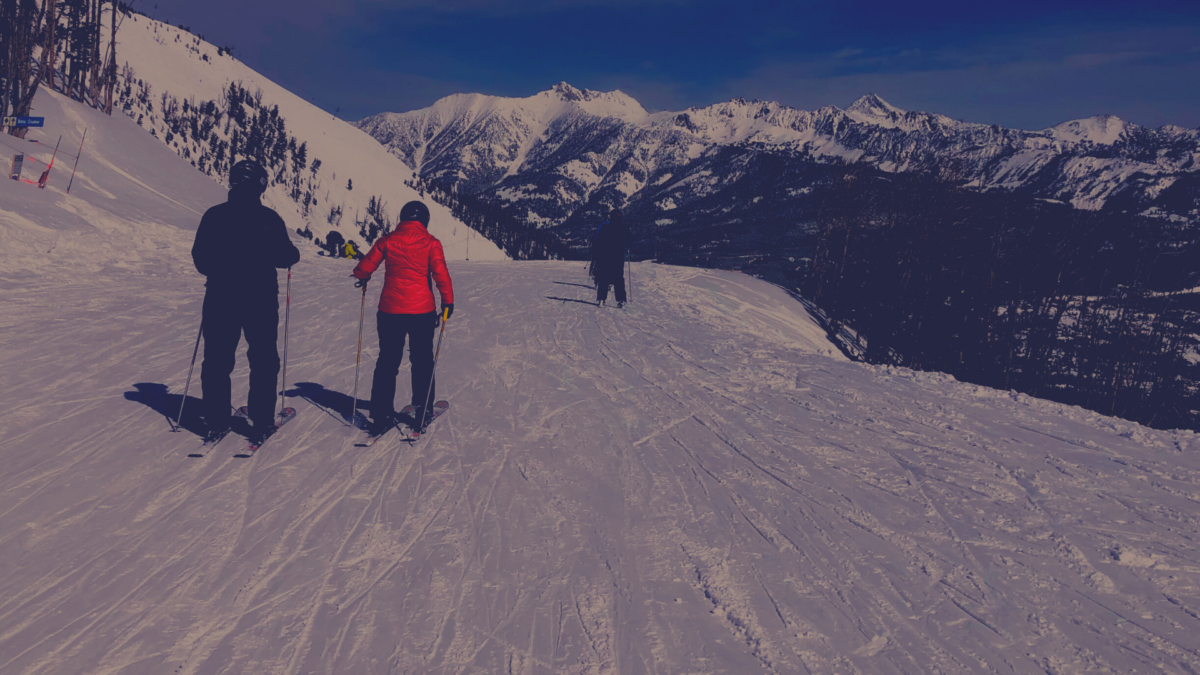
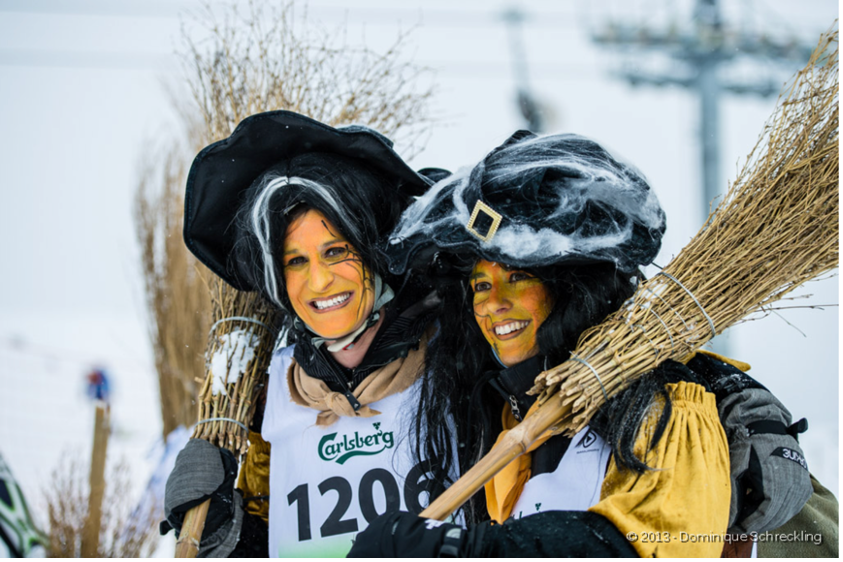
Thank you for sharing this fascinating article about the Belalp Hexe Ski Race and its connection to the history of witchcraft in Switzerland. It’s interesting to learn about the legend of the Belalp Hexe and the role it played in inspiring the race. Overall, this was a great read that provided insight into the cultural and historical context of the Belalp Hexe!
This was so interesting. I had no idea about these really incredible traditions. I found it so interesting how you revealed that the ski race was meant to be to honor the husband but I think we can all recognize that today it is to honor the witch.
To pose this question to others, who do you think you would honor in this race? Would you honor the husband or the witch?
Nice information guys, thanks